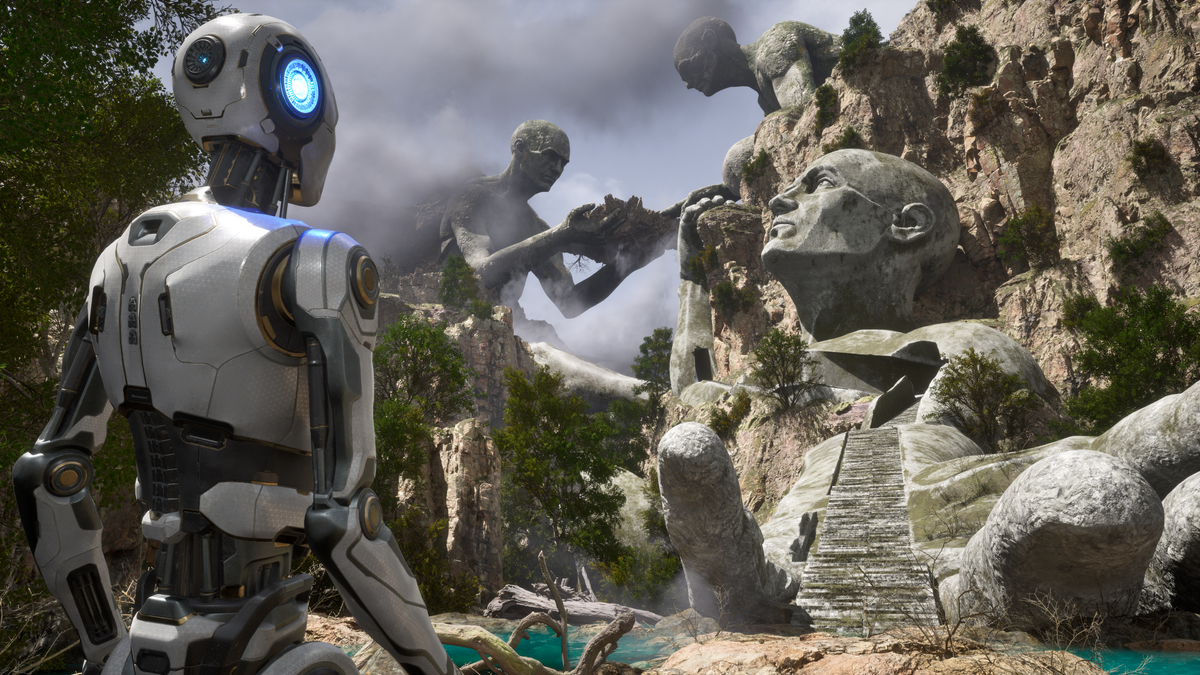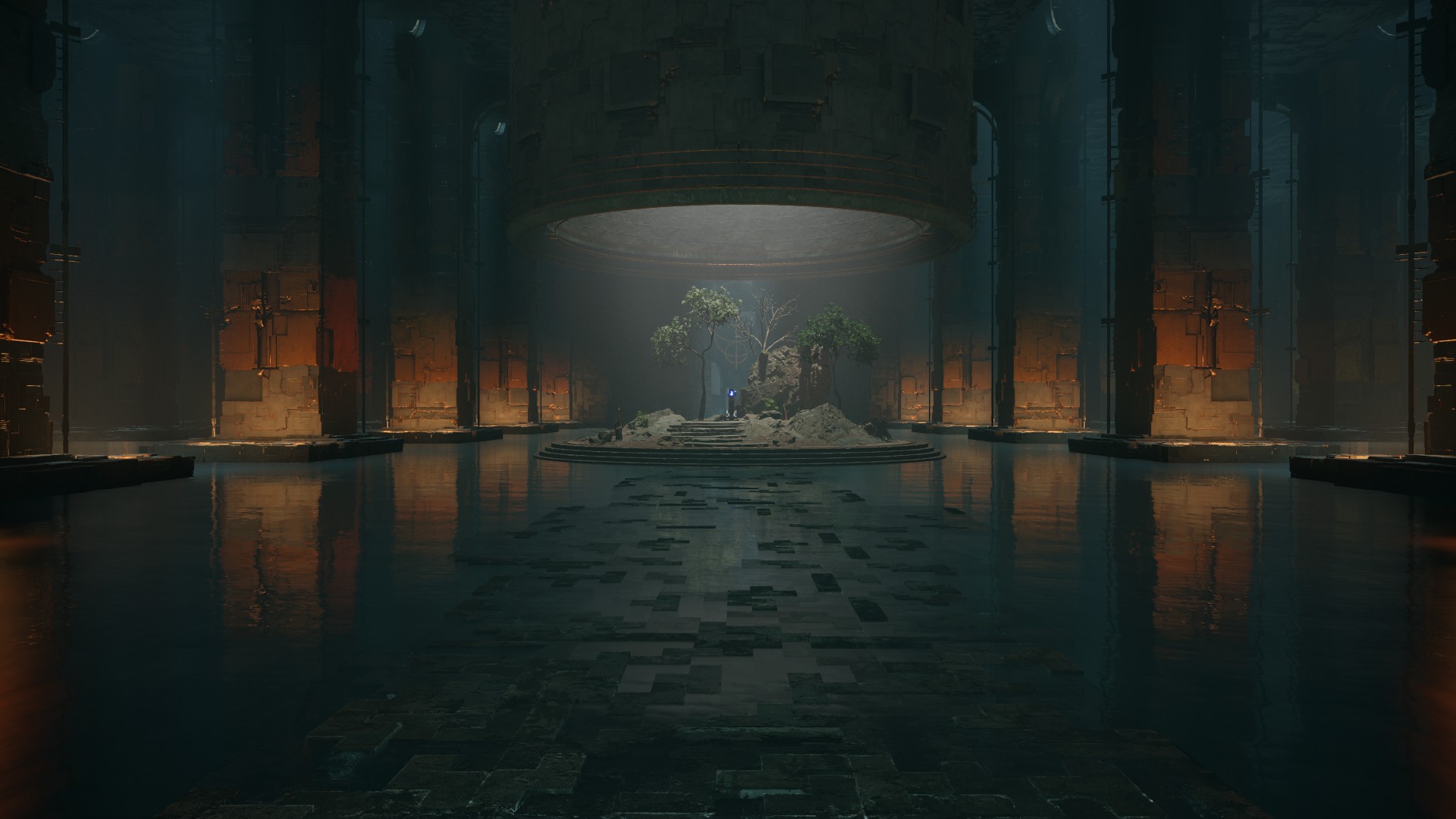
“There may be a price for pursuing progress, but there might also be a price for not pursuing it.” – Byron, The Talos Principle 2
A few weeks ago, I was able to check out a preview build of The Talos Principle 2, which showed off some new puzzle mechanics and introduced us to the story. This philosophical narrative-driven puzzle game expands on what the first game did in virtually every way, so let’s dive back in and break it down.
The Talos Principle 2 picks up thousands of years after the events of the first game. You play as 1K, the 1000th and final humanoid robot created to inhabit the city of New Jerusalem and build a new civilization. During the festivities celebrating your “birth”, a seemingly spectral figure named Prometheus appears, delivering a disturbing message and revealing the location of a mysterious new island. You set out with a handful of other robots to investigate.
While out exploring, 1K and the crew make many incredible discoveries – learning about humanity, new and old technologies, and so much more. However, the further they go, the more concerning things become. Who built this place? And why? Everyone is determined to find the answers, but what “may be the price of pursuing progress”?
The story of The Talos Principle 2 is very intriguing and thought provoking, even more so because you, or rather your player character, aren’t experiencing it alone. The other robots who have joined you will regularly chime in on discoveries, your puzzle progress, and other topics of interest, lending their own thoughts and even asking for yours. Every robot has their own personality, which is on clear display through their dialog as well as their different appearances. Some of these robots have been around since the earliest days of New Jerusalem and have seen it and a new civilization grow, although not without trials. Rome wasn’t built in a day, and New Jerusalem has its own stories to tell about its triumphs and its failures.
You’ll catch these little bits of history while out exploring, but you can also freely roam around New Jerusalem to visit any of the various exhibits around the city to learn more about The Founder, The Goal, and more. The city is basically a big museum, showing off human artifacts and other things from the years passed.
A great pyramid megastructure dominates the center of this newly revealed island. In order to gain access, you have to solve a series of puzzles to activate the three towers in each cardinal direction region. There are eight main puzzles for each tower as well as two Lost Puzzles, which can be solved in place of two of the main eight if you are struggling. Or, you can skip solving a puzzle entirely by finding and using a Prometheus Spark to unlock it. Puzzles can be completed in any order, which I’d highly recommend if you are struggling on a particular puzzle. Maybe you’ll have an epiphany while solving another puzzle.
The game brings back and builds on the puzzle mechanics from The Talos Principle, introducing a handful of new mechanics and perspectives. Things like gravity manipulation, mind transference, the RGB converter, and more join the established mechanics of the first game, giving the experience a fresh but also familiar look and feel. It’s important to take your time with each puzzle. None of the solutions are time-based nor do they require fast-paced movement, so there’s no pressure. And, while each puzzle has an intended solution, if you can think of a different way to solve it, the more power to you. Creative problem solving is very much encouraged in this game. As Jonas Kyratzes from developer Croteam puts it, “This is a contemplative game at heart,” and it’s “meant to make you think about where we are, where we came from, and where we’re going.” So, stop and smell the virtual roses, you’ve got all the time in the world.
After activating the three towers in a region, you’ll be able to enter the megastructure where you’re sure to make some big discoveries and revelations. There are more puzzles inside that, when completed, will grant you access to a data terminal. After using the terminal and learning what it has to tell you, you’ll head out to the next region and repeat the process.
I am oversimplifying this a bit, probably making it sound a bit boring and monotonous, but this is simply because I don’t want to spoil the game. The story and the events that occur are far from boring, and it was very easy to lose track of time while playing. Each region will likely take a few hours to complete, especially if you’re looking for all of the hidden secrets. All-in-all, it’ll take close to 30 hours to complete the entire game. Even after nearly 20 hours, I was only about halfway through the game because I wanted to do and find all of the things. There’s also a photo mode, so I stopped often to take epic snapshots of my surroundings, structures, and other discoveries, so you can imagine how long it took for me to finish the game.
Throughout your journey, you’ll explore a variety of beautiful environments, from the pristine city of New Jerusalem to the snowy mountains in the north to bogs and forests and so many other places. Each area is open to freely explore when you need a break from puzzles or if you want to take a detour to check out something else before moving onto the next one. Some areas are definitely more interesting than others, but each offers their own unique challenges and secrets to uncover.
Freedom of expression and overall free will are big parts of what makes us human, and a group of people with those abilities together is what makes a society learn, grow, and thrive. Even though everyone in New Jerusalem is a robot, they were created as fully sentient beings, capable of forming their own opinions and making their own decisions.
The underlying theme of The Talos Principle was what it meant to be human. The Talos Principle 2 takes that another step further to redefine what it means to be a civilization. I opened this review with a quote from one of our companions, Byron, about the price of pursuing progress. Each of your companions has their own reservations about what is going on, what it all means, and what should (or shouldn’t) be done. Everyone knows that something should be done, but what that something is is the biggest point of contention. Some are fearful of repeating humanity’s mistakes, some are afraid of what will happen if they push the boundaries too far, and some are wondering what will happen to them if they become too complacent.
When speaking with your companions, you are able to alter the course of the conversation with your responses. The variety of responses available gives players plenty of room to choose which way they’d like the discussion to go, which is refreshing as most games feel like they’re trying to tailor the conversation down specific paths. I felt like the available responses always had an option that legitimately followed my train of thought, even when it seemed like I was steering the conversation away from what may have been its intended path. The characters responded in thoughtful ways as well, maybe not necessarily changing their opinions but at least causing them to contemplate the differing perspective. I was able to push back when I had my mind set on things, and the game responded appropriately by letting me continue down my own path. Is it always the right path? No, but the game let me choose that path anyway.
The Zagreb-based developer, Croteam, has been in the game now for 30 years, having come a long way from their first original game, Football Glory, and their highly acclaimed Serious Sam franchise. We were first introduced to The Talos Principle in 2014 in Sigils of Elohim, which established the core mechanics of the series. Later that same year, The Talos Principle was launched on PC, winning numerous awards and high praise from critics and players alike. It was followed in 2015 by the Road to Gehenna DLC and has since then garnered over three million players. Their decades of experience are on clear display in The Talos Principle 2. Each puzzle is intricately designed, the story is deep, and the world is so much fun to explore.
Admittedly, what caught my attention with the first game was the small kitten in the arms of a robot on the cover. Unfortunately the game didn’t click for me right away and was all but lost in my memory until within the last few years I discovered similar games like The Witness and, more recently, Viewfinder. I was eager to revisit the game after The Talos Principle 2 crossed my radar. These philosophical puzzle games have earned a special place in my heart.
There are a few hiccups, but the team has been hard at work patching things up leading up to launch. Still, don’t be surprised if you see some pop-in, occasionally clip through what should be a solid surface, or some other little bug occurs. I’ve not experienced anything game breaking or that even needed me to restart the game, just the random minor inconveniences that sometimes happen. Updates and patches are planned to continue rolling out to address concerns as they come.
Something that may come as an initial surprise, however, is the download size. The Talos Principle was a fairly small download, maybe 10 to 20GB. The Talos Principle 2 is a staggering almost 75GB in comparison. It’s also recommended that the game be downloaded onto an SSD, which is becoming the norm nowadays as the development of games become more and more complex. None of this is necessarily a con, just something to think about. The second surprise, however, is that this chunky, adventure-filled package is only $29.99 USD, which I’d consider to be on the low end given all that the game has to offer. A very welcome surprise indeed.
The Talos Principle 2
Excellent
The Talos Principle 2 is a philosophical puzzle adventure game that’s also thought-provoking and has a deep narrative. It takes the foundation laid by the first game and expands on it in every way possible.
Pros
- Play your way and at your own pace
- Deep and thought-provoking philosophical narrative
- A pretty big package with a small price tag
Cons
- Occasional graphical and performance hiccups
- Larger download than I’d expected




